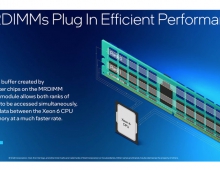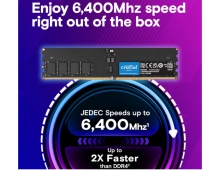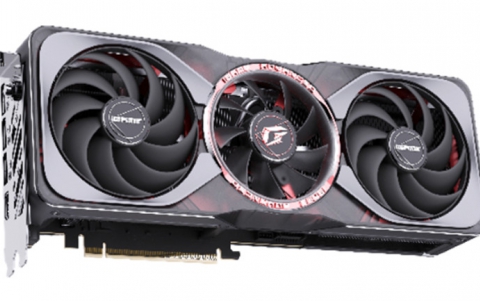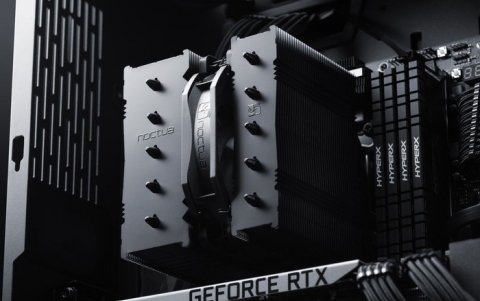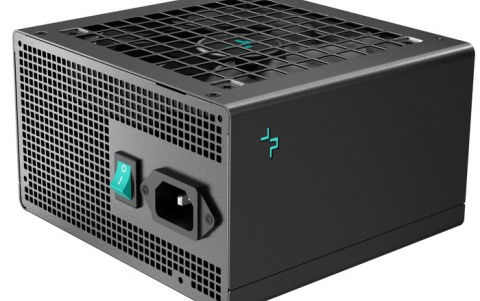
Intel Rolls Out Atom Processors at IDF Shanghai
Intel is rolling out five new Atom microprocessors and Intel Centrino
Atom processor chips designed for portable gadgets that access the
Internet and for other uses.
The low-power, tiny Atom chips will come in speeds of up to 1.86GHz
and Intel says that speed, will support Enhanced Intel SpeedStep
technology while selected SKUs will support Intel Hyper-Threading
technology, make it the fastest processor that consumes 3 watts has a
thermal design power range of 0.65 to 2.4 watts (versus 35 watts for
today's typical laptop), average power range of 160-220 milliwatts
(mW) and idle power range of 80-100mW.
 The technology package includes the Intel Atom processor (formerly
codenamed "Silverthorne") plus a single-chip with integrated graphics
called the Intel System Controller Hub that enables PC-like
capabilities and long battery life in smaller devices that can fit in
your pocket. The Intel System Controller Hub is an integrated
low-power solution that features advanced low-power 3-D graphics
features, hardware accelerated 720p and 1080i HD video decode
capabilities, Intel High Definition Audio, and a combination of PC and
handheld I/O capabilities such as PCI Express, USB Host and Client,
and SDIO. Intel Centrino Atom processor technology also enables
manufacturers to integrate a range of wireless connectivity options,
including Wi-Fi, WiMAX and cellular data.
The technology package includes the Intel Atom processor (formerly
codenamed "Silverthorne") plus a single-chip with integrated graphics
called the Intel System Controller Hub that enables PC-like
capabilities and long battery life in smaller devices that can fit in
your pocket. The Intel System Controller Hub is an integrated
low-power solution that features advanced low-power 3-D graphics
features, hardware accelerated 720p and 1080i HD video decode
capabilities, Intel High Definition Audio, and a combination of PC and
handheld I/O capabilities such as PCI Express, USB Host and Client,
and SDIO. Intel Centrino Atom processor technology also enables
manufacturers to integrate a range of wireless connectivity options,
including Wi-Fi, WiMAX and cellular data.
Intel is introducing five Intel Atom processors and three versions of its controller hub:
Z540 1.83GHz 2.4W
Z530 1.6GHz 2W
Z520 1.33GHz 2W
Z510 1.1GHz 2W
Z500 800MHz 0.6~0.7W
These low-power levels are achieved as a result of several processor design power management techniques such as Intel Deep Power Down Technology (C6), CMOS mode, and Split I/O power supply.
Intel made the announcements at its Intel Developer Forum conference on Wednesday in Shanghai.
"Global Internet growth continues unabated," said Anand Chandrasekher, who runs Intel's Ultra Mobility Group. "The best Internet experience is still on the PC, but users want to carry that experience with them."

Chandrasekher said major device makers are already planning to adopt Atom, with more than 20 manufacturers coming out with products using the processor. As far as MIDs, those will start shipping in May, he said.
He said Intel expects about 30 percent of those MIDs to have both WiFi -- short range high-speed wireless Internet access -- and WiMax -- longer-range high-speed access designed into them.
MID device makers include Asus, Fujitsu, Lenovo, NEC, Panasonic, Samsung, Sharp and Toshiba, among others, and prices will probably average about $500, with some priced higher than that or lower, depending on the functions.
The small size of the Atom processor -- the die of the chip is less than 25 square millimeters, or about a 10th of the low- cost Celeron desktop and notebook PC chip -- also lets Intel target the embedded market.
Intel gets nearly 2,700 Atom processors from a single inner-plate-size silicon wafer, according to Intel representatives.
Gelsinger: Milliwatts to Petaflops
During his keynote, Pat Gelsinger, senior vice president and general manager of Intel's Digital Enterprise Group, said Intel Architecture (IA) processors now span MIDs to High- Performance Servers (HPC).
Gelsinger provided some technical details of Intel's next-generation processor family, codenamed "Nehalem," which will begin production in the fourth quarter. Nehalem will first be seen in high-end desktop processors and dual processor server systems, and expand to other market segments in 2009. Nehalem is designed to scale from two to eight cores. Gelsinger also disclosed Intel's Advanced Vector Extension new instructions that are planned for a family of processors due after Nehalem, codenamed "Sandy Bridge" in 2010.
Gelsinger concluded his keynote talking about Intel's Visual Computing vision and need for more compute performance, higher memory and I/O bandwidth, improved graphics, better software tools and libraries in order to deliver photo-realistic 3-D rendering, high-definition video and audio. One critical element will be the "Larrabee" Architecture, which will feature many Intel architecture cores, a new cache architecture and new vector processing instruction set.
Perlmutter: Personalized Mobility On The Way
Also at IDF, Dadi Perlmutter, executive vice president and general manager of Intel's Mobility Group, discussed the wave of personalization on tap that takes advantage of new notebook and netbook products coming to market later this year. Intel will deliver its next-generation "Montevina" Intel Centrino 2 processor technology for notebooks in June providing faster performance and longer battery life.
Centrino 2 will be the first platform from Intel to offer an integrated Wi-Fi and WiMAX wireless access option that is expected to be available in certain notebooks in the second half of the year. Other options for Centrino 2 include the processor and other components that are about 40 percent smaller, making them ideal for the mini- and sub-notebook categories. Perlmutter shared details in graphics quality and native hardware support for high-definition entertainment using Blu Ray, and demonstrated Intel solid state drive technology.
Looking ahead Perlmutter offered a first peek at Intel's 2009 notebook platform codenamed "Calpella." Before that and toward the end of 2008, Perlmutter said the company will bring Intel Anti-theft Technology. The technology focuses on asset recovery, theft management and data protection and will arrive in laptops by year's end.
Perlmutter also showcased two laptops called "netbooks" while articulating Intel's strategy for this emerging class of affordable, easy-to-use computers. These simple, low-cost Internet-centric devices will be powered by Intel's new purpose-built low power architecture, forthcoming "Diamondville" Intel Atom processors and unique transistor and manufacturing process that is perfectly suited for this new market opportunity.
 The technology package includes the Intel Atom processor (formerly
codenamed "Silverthorne") plus a single-chip with integrated graphics
called the Intel System Controller Hub that enables PC-like
capabilities and long battery life in smaller devices that can fit in
your pocket. The Intel System Controller Hub is an integrated
low-power solution that features advanced low-power 3-D graphics
features, hardware accelerated 720p and 1080i HD video decode
capabilities, Intel High Definition Audio, and a combination of PC and
handheld I/O capabilities such as PCI Express, USB Host and Client,
and SDIO. Intel Centrino Atom processor technology also enables
manufacturers to integrate a range of wireless connectivity options,
including Wi-Fi, WiMAX and cellular data.
The technology package includes the Intel Atom processor (formerly
codenamed "Silverthorne") plus a single-chip with integrated graphics
called the Intel System Controller Hub that enables PC-like
capabilities and long battery life in smaller devices that can fit in
your pocket. The Intel System Controller Hub is an integrated
low-power solution that features advanced low-power 3-D graphics
features, hardware accelerated 720p and 1080i HD video decode
capabilities, Intel High Definition Audio, and a combination of PC and
handheld I/O capabilities such as PCI Express, USB Host and Client,
and SDIO. Intel Centrino Atom processor technology also enables
manufacturers to integrate a range of wireless connectivity options,
including Wi-Fi, WiMAX and cellular data.Intel is introducing five Intel Atom processors and three versions of its controller hub:
Z540 1.83GHz 2.4W
Z530 1.6GHz 2W
Z520 1.33GHz 2W
Z510 1.1GHz 2W
Z500 800MHz 0.6~0.7W
These low-power levels are achieved as a result of several processor design power management techniques such as Intel Deep Power Down Technology (C6), CMOS mode, and Split I/O power supply.
Intel made the announcements at its Intel Developer Forum conference on Wednesday in Shanghai.
"Global Internet growth continues unabated," said Anand Chandrasekher, who runs Intel's Ultra Mobility Group. "The best Internet experience is still on the PC, but users want to carry that experience with them."

Chandrasekher said major device makers are already planning to adopt Atom, with more than 20 manufacturers coming out with products using the processor. As far as MIDs, those will start shipping in May, he said.
He said Intel expects about 30 percent of those MIDs to have both WiFi -- short range high-speed wireless Internet access -- and WiMax -- longer-range high-speed access designed into them.
MID device makers include Asus, Fujitsu, Lenovo, NEC, Panasonic, Samsung, Sharp and Toshiba, among others, and prices will probably average about $500, with some priced higher than that or lower, depending on the functions.
The small size of the Atom processor -- the die of the chip is less than 25 square millimeters, or about a 10th of the low- cost Celeron desktop and notebook PC chip -- also lets Intel target the embedded market.
Intel gets nearly 2,700 Atom processors from a single inner-plate-size silicon wafer, according to Intel representatives.
Gelsinger: Milliwatts to Petaflops
During his keynote, Pat Gelsinger, senior vice president and general manager of Intel's Digital Enterprise Group, said Intel Architecture (IA) processors now span MIDs to High- Performance Servers (HPC).
Gelsinger provided some technical details of Intel's next-generation processor family, codenamed "Nehalem," which will begin production in the fourth quarter. Nehalem will first be seen in high-end desktop processors and dual processor server systems, and expand to other market segments in 2009. Nehalem is designed to scale from two to eight cores. Gelsinger also disclosed Intel's Advanced Vector Extension new instructions that are planned for a family of processors due after Nehalem, codenamed "Sandy Bridge" in 2010.
Gelsinger concluded his keynote talking about Intel's Visual Computing vision and need for more compute performance, higher memory and I/O bandwidth, improved graphics, better software tools and libraries in order to deliver photo-realistic 3-D rendering, high-definition video and audio. One critical element will be the "Larrabee" Architecture, which will feature many Intel architecture cores, a new cache architecture and new vector processing instruction set.
Perlmutter: Personalized Mobility On The Way
Also at IDF, Dadi Perlmutter, executive vice president and general manager of Intel's Mobility Group, discussed the wave of personalization on tap that takes advantage of new notebook and netbook products coming to market later this year. Intel will deliver its next-generation "Montevina" Intel Centrino 2 processor technology for notebooks in June providing faster performance and longer battery life.
Centrino 2 will be the first platform from Intel to offer an integrated Wi-Fi and WiMAX wireless access option that is expected to be available in certain notebooks in the second half of the year. Other options for Centrino 2 include the processor and other components that are about 40 percent smaller, making them ideal for the mini- and sub-notebook categories. Perlmutter shared details in graphics quality and native hardware support for high-definition entertainment using Blu Ray, and demonstrated Intel solid state drive technology.
Looking ahead Perlmutter offered a first peek at Intel's 2009 notebook platform codenamed "Calpella." Before that and toward the end of 2008, Perlmutter said the company will bring Intel Anti-theft Technology. The technology focuses on asset recovery, theft management and data protection and will arrive in laptops by year's end.
Perlmutter also showcased two laptops called "netbooks" while articulating Intel's strategy for this emerging class of affordable, easy-to-use computers. These simple, low-cost Internet-centric devices will be powered by Intel's new purpose-built low power architecture, forthcoming "Diamondville" Intel Atom processors and unique transistor and manufacturing process that is perfectly suited for this new market opportunity.






